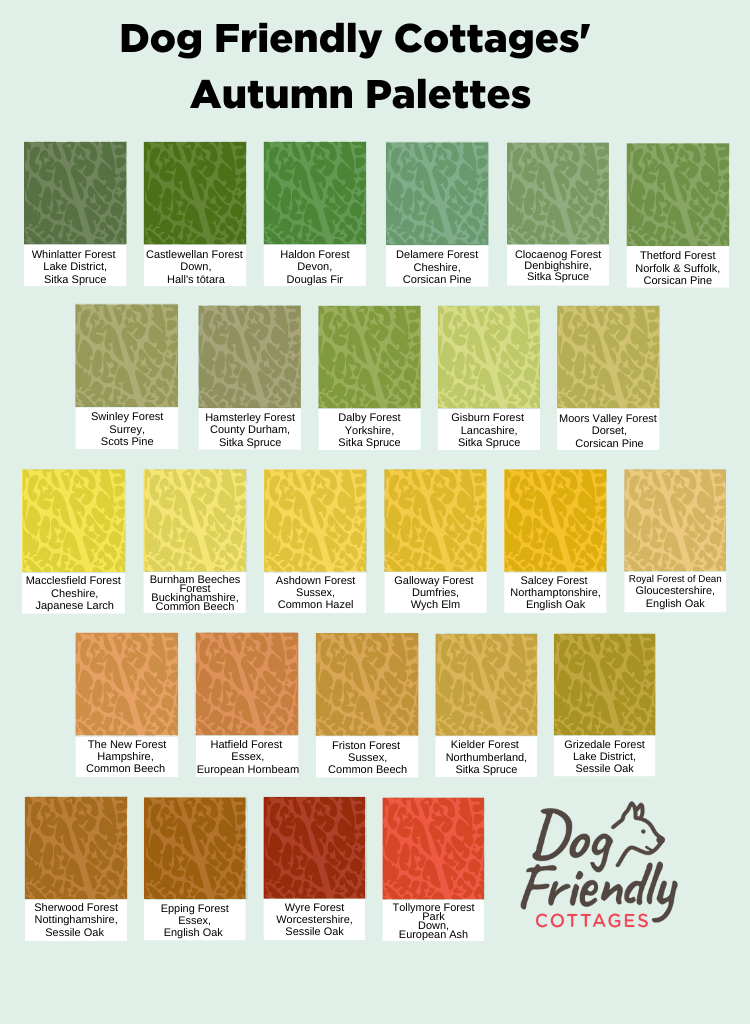50 Shades of Trees: The ultimate guide to choosing a colour therapy holiday this autumn

A leading pet-friendly holiday marketplace has created The Colour Therapy Holidays Collection, designed for holidaymakers to choose the perfect autumnal break based on the feelings and emotions each local forest’s colours are said to bring out. Interest in the impact colour has on human psychology has never been higher, with searches for ‘calming colours’ more than doubling in the last five years¹, while three in every 100 people experience some form of seasonal depression2. According to colour psychology, Sherwood Forest will leave visitors rejuvenated, while visitors to Delamere Forest will find themselves feeling healed and stable, and The New Forest will help people feel more confident after a visit.
Leading pet-friendly holiday marketplace, Dog Friendly Cottages, has revealed The Colour Therapy Holidays Collection, a comprehensive colour guide to the UK’s forests, highlighting the ideal locations for an autumn staycation.
The dominant tree species³ in each of the 25 most photographed forests in the UK⁴ was looked at to determine each forests’ individual colour palette. Each autumn leaf colour of each tree species was studied and matched with the feeling or emotion it best evokes according to colour psychologists⁵.
DFC Leaves Plaettee.png
The full study, including the curated destinations in The Colour Therapy Holidays Collection and an expert’s guide to forest walks with dogs, can be viewed here: https://www.dogfriendlycottages.co.uk/colour-therapy-holidays
The most prevalent shade throughout British forests is the golden brown of the Oak tree, with the two most common species of Oak, the Sessile Oak and English Oak making up over a fifth of all broadleaf forest across the UK⁵. A walk through a forest of Oak trees will evoke feelings of encouragement and optimism, coupled with hope, happiness and fun from the yellow hues⁶ within the leaves, which turn a golden brown during the autumn months.
The best forests in the UK to enjoy the traditional golden brown leaves of Oak trees are:
Royal Forest of Dean (English Oak)
Sherwood Forest (Sessile Oak)
Epping Forest (English Oak)
Wyre Forest (Sessile Oak)
Forests housing a large population of Hazel, Beech or Elm trees can help inspire creative thoughts, as the yellow leaves of these trees resonate with the left side of the brain, inspiring new ideas and creativity⁶.
The best forests in the UK to see brighter golden yellow leaves are:
The New Forest (Common Beech)
Ashdown Forest (Common Hazel)
Galloway Forest (Wych Elm)
Macclesfield Forest (Japanese Larch)
One of the rarer autumn shades is the distinctive bright red of the European ash leaf, which can be seen in the landscape of Tollymore Forest Park in Northern Ireland. Red shades can encourage feelings of strength and courage, giving confidence to those who are shy or lacking willpower⁶.
However, not all UK forests share the same autumnal colour palette, with some dominated by evergreen species that even in the cooler months display the shades representing balance and growth. Green shades evoke feelings of rest and security, symbolising stability, with darker greens also relating to wealth and prestige⁶. Forests dominated by Pines such as Corsican Pine and Scots Pine, Fir trees and Conifers are the ideal locations for provoking these emotions.
The evergreen forests which are best to visit for green shades are:
Hamsterley Forest (Sitka Spruce)
Delamere Forest (Corsican Pine)
Swinley Forest (Scots Pine)
Haldon Forest (Douglas Fir)
Castlewellan Forest Park (Hall’s tōtara)
Greens can also represent feelings of healing, with lighter greens relating to rebirth, growth and freshness⁶.
For a whole family trip, dogs included, Whinlatter Forest in the Lake District is an ideal destination, with over 900 dog-friendly accommodation options available nearby and miles of walking trails for all to enjoy⁷.
Matthew Fox, CEO of the Snaptrip Group, said,
“The increasing popularity of colour psychology and the importance of mental health and wellbeing made us consider the impact that the colours of nature can have on our emotions. It’s estimated that three in every 100 people in the UK experience some form of seasonal depression during autumn and winter months8, and we wanted to see how the iconic colours of autumn could help people alleviate those feelings.
“That’s why we’ve created The Colour Therapy Holidays Collection, to help use the shades of the forest to positively influence our psychology on autumn breaks. With plenty of forests to choose from, we hope the collection will help encourage more people to get out into nature with their dogs and embrace the beauty of the UK’s forests.”






